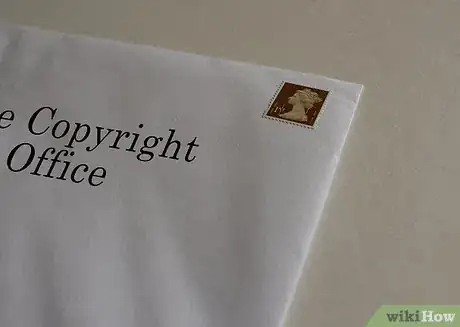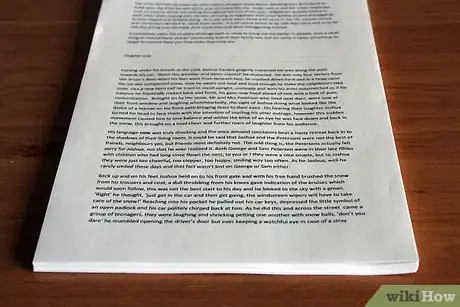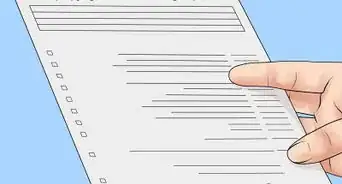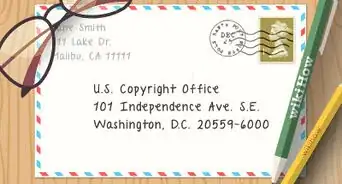wikiHow is a “wiki,” similar to Wikipedia, which means that many of our articles are co-written by multiple authors. To create this article, volunteer authors worked to edit and improve it over time.
wikiHow marks an article as reader-approved once it receives enough positive feedback. In this case, 90% of readers who voted found the article helpful, earning it our reader-approved status.
This article has been viewed 81,785 times.
Learn more...
Writers have adopted pseudonyms or pen names to disguise themselves for a number of reasons: to hide their true gender (Alice Sheldon writing as James Tiptree, Jr.), to hide their work in a different area (Isaac Asimov writing juvenile science fiction as Paul French), to hide the sheer volume of their work (Robert Heinlein writing as Anson McDonald and under other names) or just their being writers (Michael Crichton as Jeffrey Hudson). Pen names have also been created by publishing houses to unify book series, such as "Franklin W. Dixon" and "Carolyn Keene" for the Hardy Boys and Nancy Drew mystery series, and "Kenneth Robeson" for the Doc Savage and Avenger series. Regardless of the reason for authors writing under a pen name, the U.S. Copyright Office provides protection for works written as a pseudonym. Here's how to copyright a book with a pen name.
Steps
-
1Decide whether you want to reveal your name to the Copyright Office. You do not have to give your real (legal) name to the Copyright Office to register your copyright. If you choose not to give your real name when registering your work, it receives copyright protection for either 95 years from when it was published or 120 years from when it was created, whichever period ends earlier. If you choose to give your real name, it remains part of the Copyright Office's records and cannot be removed later. However, the length of time your work receives copyright protection becomes the same as if you had written and registered it under your real name, the author's life plus another 70 years.
- If you choose not to give your real name at the time you register your copyright, you can provide it to the Copyright Office at a later time. If you register a subsequent work using your real name as well as your pen name, previous works written under that pen name are then given copyright protection for the author's life plus 70 years.
-
2Consider pre-registering your work. Preregistration does not replace registration, but it permits you to sue for copyright infringement while your work is still in development if you feel there's a likelihood of someone doing so before you complete it. (This would be most likely if you're writing a book in a genre made popular by the phenomenal success of a particular work, such as the Harry Potter or "Twilight" books.) Preregistration is also available for works of music, sound recordings, computer software, motion pictures and photographs used in marketing or advertising.
- You can only pre-register a work online by submitting a description of it no more than 2,000 characters (about 330 words) in length and a filing fee, which can be paid by credit card, through the Automated Clearing House (ACH) network or through an account you previously established with the Copyright Office. (You do not include the work itself.) For more information about preregistration, see http://www.copyright.gov/prereg/help.html#how_to.
- Once the Copyright Office processes your preregistration application, they will notify you by e-mail. The e-mail notice will include the information you sent, a preregistration number and the date on which preregistration became effective. You can get a certified copy of the notice from the Copyright Office's Certifications and Documents section.
- Once you pre-register your work, you must register the copyright within 3 months of publishing it or within a month after you learn someone has infringed your copyright. If you don't register within this time, you'll be unable to bring suit against an offending party until more than 2 months have passed since you published your work.
Advertisement -
3File your registration with the Copyright Office. You may do so in 1 of 3 ways: using the online electronic Copyright Office (eCO), downloading fill-in Form CO and completing it on your personal computer or obtaining a paper registration form from the Copyright Office. Whichever method you use, you must fill in the "Copyright Claimant" space and also check the "Pseudonymous" box to indicate that you're using a pen name. You must include the required payment with your application.
- To access the electronic option, select "electronic Copyright Office" from the Copyright Office website (http://www.copyright.gov/). You'll be asked whether you intend to submit an electronic or a hard copy of your work. (You may submit either an electronic or hard copy of any unpublished work with this option.) Filing electronically lets you file for less money than the other 2 options, and also provides you with faster processing, the ability to pay electronically, e-mail acknowledgment of your submission and online tracking of the status of your application.
- Fill-in Form CO can be obtained by selecting "Forms" on the Copyright Office website at http://www.copyright.gov/. This form includes a barcode that permits the Copyright Office to process the form with its scanners; because each barcode is unique to the registration application, you can only use Form CO to register the work for which you requested it. After completing the form on your computer, you then print it out.
- Requests for paper forms must be addressed to the Library of Congress, U.S. Copyright Office-TX, 101 Independence Avenue SE, Washington, DC 20559-6221. (The relevant form for a book is Form TX.) Use the same address to submit a copyright registration and your payment by mail; a completed Fill-in Form CO is sent to the same address. (You may also print out your electronic registration form and send it by mail if you wish, but you then pay the higher fee for non-electronic processing.)
-
4Deposit a copy of your work with the Copyright Office. If your work is unpublished, a complete copy of the manuscript is required. If your work has been published since 1978, the Copyright Office then requires 2 complete copies of the best edition. (If it was published before 1978, the requirement is 2 copies of the first edition.)
- If you filed your registration electronically, the Copyright Office will prompt you to print out a shipping slip to go with your hard copy deposit. It is only good for the work you are registering.
Community Q&A
-
QuestionIf I haven't written yet, can I have a pen name?
 Community AnswerYes, if you haven't written yet, you can still have a pen name.
Community AnswerYes, if you haven't written yet, you can still have a pen name. -
QuestionDoes copyrighting something cost money?
 Community AnswerYes, $35-$55 if you do it yourself or $250-$500 if you hire an attorney to help you.
Community AnswerYes, $35-$55 if you do it yourself or $250-$500 if you hire an attorney to help you. -
QuestionIf I select the box for a pseudonym on the copyright form and reveal my real name on the form, but choose a pen name, is the copyright office or Library of Congress obligated to keep my real name private?
 Community AnswerNo, they are not. If you provide your real name, it goes on the Copyright Office's online public records and can be accessed by anyone via the internet. You will not be able to remove it if you change your mind.
Community AnswerNo, they are not. If you provide your real name, it goes on the Copyright Office's online public records and can be accessed by anyone via the internet. You will not be able to remove it if you change your mind.
Warnings
- Using a pen name can also complicate selling subsidiary and reprint rights to your work, your heirs' inheritance of your rights and foremost, the processing of your advance and royalty payments. Before deciding to use a pen name, consult a lawyer for assistance in avoiding these issues.⧼thumbs_response⧽
- Do not use a pen name to capitalize on another writer's fame, attempt to wriggle out of a "first look" clause with your current publisher, dodge a libel lawsuit or avoid paying income taxes.⧼thumbs_response⧽














-Step-13.webp)















































